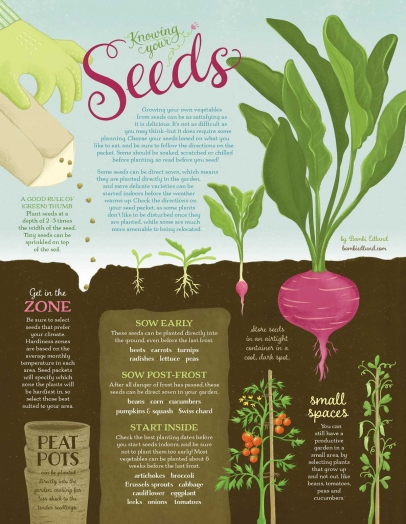Knowing Your Seeds
Growing your own vegetables from seeds can be as satisfying as it is delicious. It’s not as difficult as you may think—but it does require some planning. Choose your seeds based on what you like to eat, and be sure to follow the directions on the packet. Some should be soaked, scratched or chilled before planting, so read before you seed!
Some seeds can be direct sown, which means they are planted directly in the garden, and more delicate varieties can be started indoors before the weather warms up. Check the directions on your seed packet, as some plants don’t like to be disturbed once they are planted, while some are much more amenable to being relocated.
A GOOD RULE OF (GREEN) THUMB
Plant seeds at a depth of 2–3 times the width of the seed. Tiny seeds can be sprinkled on top of the soil.
Get in the ZONE
Be sure to select seeds that prefer your climate. Hardiness zones are based on the average monthly temperature in each area. Seed packets will specify which zone the plants will be hardiest in, so select those best suited to your area.
PEAT POTS
can be planted directly into the, less shock to the tender seedlings.
SOW EARLY
These seeds can be planted directly into the ground, even before the last frost.
Beets ● carrots ● turnips ● radishes ● lettuce ● peas
SOW POST-FROST
After all danger of frost has passed, these seeds can be direct sown in your garden.
beans ● corn ● cucumbers ● pumpkins & squash ● Swiss chard
START INSIDE
Check the best planting dates before you start seeds indoors, and be sure not to plant them too early! Most vegetables can be planted about 6 weeks before the last frost.
artichokes ● broccoli ● Brussels sprouts ● cabbage ● cauliflower ● eggplant ● leeks ● onions ● tomatoes
Store seeds in an airtight container in a cool, dark spot.
small spaces
You can still have a productive garden in a small area, by selecting plants that grow up and not out, like beans, tomatoes, peas and cucumbers.





